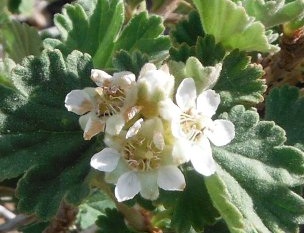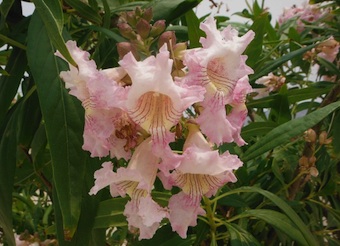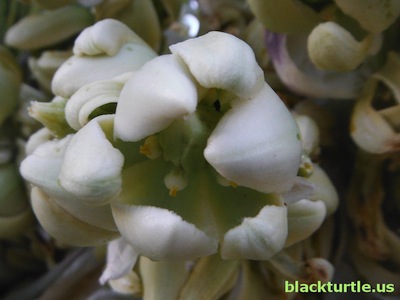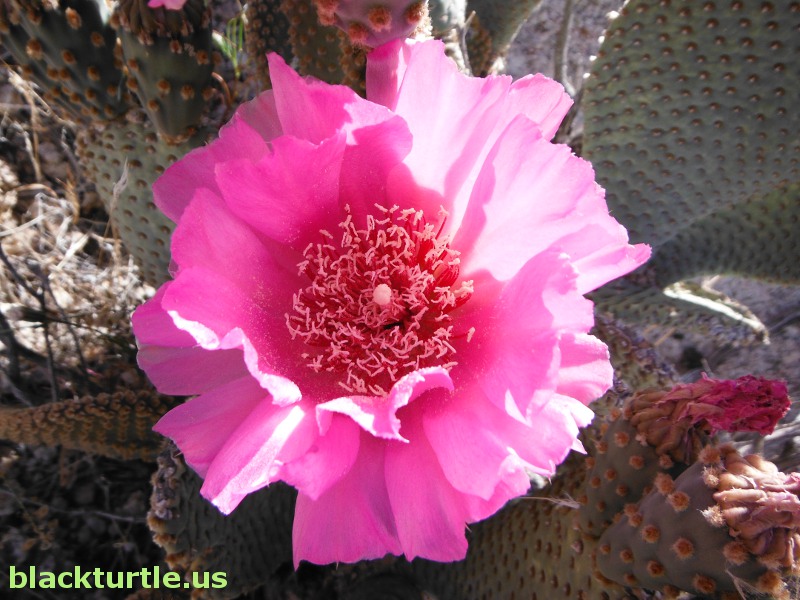|
|

|
Nevada Ninebark
January/February
There are a number of plants which grow at higher elevations within the
boundaries of Death Valley National Park (DVNP) which aren't exactly what you'd
call typical desert plants. Nevada Ninebark is one of those plants. It grows
primarily in pinyon/juniper woodlands at elevations above 5800 feet. Around
DVNP it grows in the Inyo, White, Cottonwood, and Panamint ranges. The
specimen shown here was found on the west side of the Panamint Range at an
elevation of 9200 feet, near Telescope Peak.
(Click here for more info!)
|

|
Desert Willow
March/April
Although not prevalent as a native of the Death Valley area, Desert Willow
(Chilopsis linearis) does show up
here and there, especially as a landscape plant around museums and other
structures found in the park. Native to the Desert Southwest and found from
Texas to California and south into Mexico, this plant is well-adapted to
conditions found at lower elevations, especially conditions which are
prevalent in the southeastern portion
of the park. Oddly enough, the leaves of this plant fall off when the
temperature drops below forty-one degrees on the Fahrenheit scale.
(Click here for more info!)
|

|
Wire Lettuce
May/June
Wire Lettuce is known by several common names including Desert Straw, Prairie
Skeleton Plant, and Desert Milk-Aster, as well as a couple other possilities.
Desert Straw is an appropriate name for the plant since when it is dried out
it looks somewhat like a pile of hay or straw. On the other hand, Desert
Milk-Aster also works since young plants produce milky sap. As for Pairie
Skeleton Plant, this name is a good fit as well since the plant produces few leaves and the
tangled stems can look a little bit like a pile of bones. I suppose the
lesson to be learned here is that common names can be confusing and so it's
a good thing that plants have scientific names as well as informal nicknames!
(Click here for more info!)
|

|
Joshua Tree
July/August
Joshua trees produced what has been called a historic bloom during the
spring of 2013. Also known as Yucca brevifolia, these plants are
somewhat unpredictable when it comes to producing flowers during the spring.
Some years they do and some years they don't. But this year lots of flowers
have been produced and no one seems to be able to adequately account for
this event.
While some have attempted to attribute this abundant bloom to global
warming, it seems that the best theory has to do with late summer
thunderstorms and colder than normal winter temperatures.
(Click here for more info!)
|

|
Beavertail Cactus
September/October
It has been much drier than normal so far this year and it was much drier
than normal last year also, but one plant has managed, nevertheless, to
produce flowers in abundance and that plant is the Beavertail Cactus, or
Opuntia basilaris, to use its formal name. The flowers of this plant are
usually said to be magenta, but sometimes the word cerise is used to
describe their color. Cerise is defined as somewhere between a deep to vivid reddish pink.
That pretty much sums up the color of the flowers of the Beavertail Cactus
and so it works, although most people will probably stick with magenta or
deep pink or something simple like that!
(Click here for more info!)
|

|
Box Thorn
November/December
To observe the flowers on this shrub, your timing must be pretty good since
they last only a few days. To further reduce the chances of spotting
this thorny bush while it is producing flowers is the fact that it may bloom
during March, April, or May, depending on what the weather has been
like during a particular year. However, should you be fortunate enough to
catch this bush while it is in bloom, you will be treated to some rather
attractive, but small, flowers ranging in color from pale lavender to almost
purple.
(Click here for more info!)
|
|
| |
|

blackturtle.us
PLANT
BLOG
BLOG INDEX
ASSOCIATED SITES:
Trona News
Rusky Ed
Any Place Education








|

















